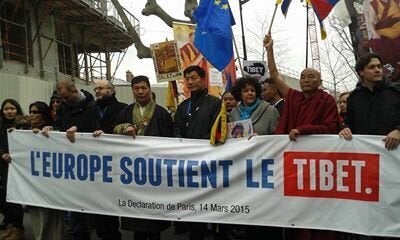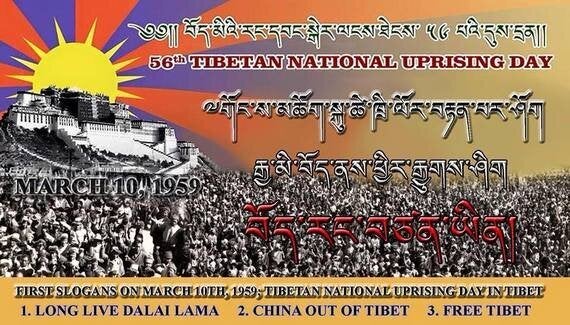A little learning is a dangerous thing;
Drink deep, or taste not the Pierian spring. - Alexander Pope
March 10 is the day exile Tibetans annually commemorate the Tibetan Uprising in 1959 against the brutal and illegal occupation by Chinese communists. The failure of the armed rebellion ultimately resulted in a violent crackdown on Tibetans, and the flight of the Dalai Lama into exile. After over six decades under occupation, without any sign of a change in policy, it is credit to the many Tibetan exiles and their western supporters who came together to show solidarity with Tibetans in Tibet.
Sadly, tensions among US Tibetan exile activists led to a public fight in New York, that was videoed and posted on social media. The video shows Rangzen (Independence) and Umay Lam (Middle Way) activists in verbal conflict about marching together and the wording on the banners they were holding. A US policeman is seen advising them about the right to free speech under the First Amendment. Online eyewitness accounts differ, with some blaming the Tibet Government in exile and their heavy-handed tactics in ensuring a unified message and others blaming the aggressive, intimidating approach of Rangzen supporters.
As a long-term Tibet supporter, I was filled with sadness watching an incident that will be seen as 'shooting themselves in the foot'. Thankfully, this was not repeated in the European Solidarity with Tibet event on March 14, at which hundreds of people, including Tibetan exile leader, Dr. Lobsang Sangay attended.

Exile Prime Minister, Dr. Lobsang Sangay, during a rally on March 14, 2015 in Paris, France
Although, at one level, such conflict might be seen as political, at another level, it is symptomatic of an underlying tension between the exile 'educated' youth and an older generation of Tibetans. Particularly those who have settled in North America. Scholar, Tsering Shakya recently wrote about this generation gap in 'Twice Removed' .
In addition, for the last thirty years or so, much of American academia, in order to address gross racial inequalities, has fallen at the mercy of a politically correct, Left-wing ideology that divides people in the name of post-colonialism and cultural relativism. As a result, the US-based Tibet movement now number among them advocates of a particular pseudo-intellectual, Occidentalist, hyper-nationalist brand of identity politics. Often claiming to understand and speak on behalf of Tibetans in Tibet (even if they have never been there) and indirectly suggesting that Tibetans in Tibet disagree with the Middle Way policy of the Dalai Lama and their elected leaders. It is ironic that some of the Tibetan activists shouting loudest about human eights and freedom of expression have deleted comments on social media or responded with sexism and outright abuse when people disagreed with them. So much for freedom of speech.
This growing hyper-nationalist, cultural relativist trend in the exile Tibet movement, which has been satirised on Chome Ringluk website, cannot be laughed off and sadly shows no sign of abating. On the one hand, while it is understandable that exile Tibetans are fed up with 'white saviours' in the Tibet movement (of which I wrote about here) the majority of foreign funding, passports, visas, and support for exile Tibetans, schools, projects and so on still comes from Europe, North America and Australasia. With the exception of India, wealthy, Asian countries such as Japan, Malaysia, Singapore and The Philippines have not provided anywhere near the same levels of political, moral and financial support. The expression 'don't bite the hand that feeds you' while obnoxious is nonetheless relevant here. The irony about the incident in New York, apart from the obvious one of freedom marchers apparently trying to restrict freedom of speech, is that Tibetan exile eagerness to get American passports and education may be the very thing that divides and tarnishes the movement. The hand slaps back from the stomach it fed.
On the one hand, some Tibetans , such as Samdup Tenzin, have argued that such a conflict is a symbol of the conservative Tibetan exile society's modus operandi that seeks to muzzle those brave Tibetans who speak out against the political status quo and homogeny. On the other, some claim it is the arrogance and lack of long-term thinking of Rangzen activists that threatens to jeopardise the long-term future of freedom for Tibetans in Tibet. Former Tibetan exile leader, Samdhong Rinpoche has stated that such Tibetans are more dangerous for Tibet than even Shugden and the Chinese. Strong words but not without reason. If one takes out the emotion and name-calling, there is truth on both sides of the divide.

Rangzen poster for 2015 rally
Disagreement neither justifies censoring anyone's freedom of speech nor defamation and slander. But it is also freedom of speech to express one's wish not to be associated with people who have a different ideology. Just as a woman of colour cannot claim to speak on behalf of all women of colour, not all black people agreed with or supported Malcolm X, and it was their human right to distance themselves from those who did. For the majority of Tibetan exiles, there is no doubt that the Dalai Lama's view on this issue is the wisest one, far more so than that of any well-meaning US college student or aspiring intellectual. As scholar, Robbie Barnett, said:
Meanwhile, the Tibetan youth in exile face a more urgent challenge: The gap between them and the 97 percent of Tibetans who remain inside the country is widening. It is likely that the future of the Tibetan issue will be decided by the Tibetans inside Tibet -- estimated at 6 million people. They read and write in their mother tongue more fluently than their counterparts in exile. Many of them are also fluent in Chinese, the dominant language of trade, government and education in Tibet.... After the Dalai Lama dies, those in Tibet may come to see the exiled generation as having different interests from theirs or as lacking the skills and knowledge necessary to lead the effort to settle the dispute with China.
A way out of the divide is, as London-based Tsamtruk Passang has argued, to unify around getting self-determination in Tibet. Until then, for the Tibetans in Tibet, such conflict helps no-one but the Chinese government and may be a sign that young Tibetans in exile are becoming more irrelevant. That is a tragedy and one that will not easily be resolved without more open, respectful discussion and inclusion.
